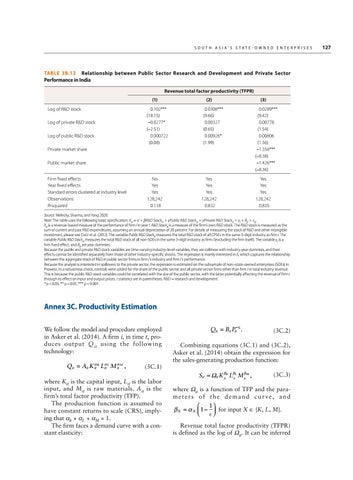SOUT H A SI A ’ S ST A TE - OWNED ENTER P RISES
TABLE 3B.12 Relationship between Public Sector Research and Development and Private Sector Performance in India Revenue total factor productivity (TFPR) (1) Log of R&D stock Log of private R&D stock Log of public R&D stock
(2)
0.102*** (18.15) –0.0277* (–2.51) 0.000722 (0.08)
0.0308*** (9.66) 0.00327 (0.65) 0.00926* (1.99)
Private market share Public market share Firm fixed effects Year fixed effects Standard errors clustered at industry level Observations R-squared
No Yes Yes 128,242 0.118
Yes Yes Yes 128,242 0.832
(3) 0.0289*** (9.42) 0.00778 (1.54) 0.00806 (1.56) –1.358*** (–8.38) –1.426*** (–8.36) Yes Yes Yes 128,242 0.835
Source: Melecky, Sharma, and Yang 2020. Note: The table uses the following basic specification: Xit = α + βR&D Stock it + γPublic R&D Stock it + γPrivate R&D Stock it + γi + θ it + εit. Xit is a revenue-based measure of the performance of firm i in year t. R&D Stockit is a measure of the firm’s own R&D stock. The R&D stock is measured as the sum of current and past R&D expenditures, assuming an annual depreciation of 20 percent. For details of measuring the stock of R&D and other intangible investment, please see Dutz et al. (2012). The variable Public R&D Stockit measures the total R&D stock of all CPSEs in the same 3-digit industry as firm i. The variable Public R&D Stockit measures the total R&D stock of all non-SOEs in the same 3-digit industry as firm i (excluding the firm itself). The variable γi is a firm fixed effect, and θit are year dummies. Because the public and private R&D stock variables are time-varying industry-level variables, they are collinear with industry-year dummies, and their effects cannot be identified separately from those of other industry-specific shocks. The regression is mainly interested in δ, which captures the relationship between the aggregate stock of R&D in public sector firms in firm i’s industry and firm i’s performance. Because the analysis is interested in spillovers to the private sector, the regression is estimated on the subsample of non–state-owned enterprises (SOEs) in Prowess. In a robustness check, controls were added for the share of the public sector and all private sector firms other than firm i in total industry revenue. This is because the public R&D stock variables could be correlated with the size of the public sector, with the latter potentially affecting the revenue of firm i through its effect on input and output prices. t statistics are in parentheses. R&D = research and development. * p < 0.05, ** p < 0.01, *** p < 0.001.
Annex 3C. Productivity Estimation We follow the model and procedure employed in Asker et al. (2014). A firm i, in time t, produces output Q it using the following technology:
Qit = Ait K itα K Litα L M itα M , (3C.1)
where Kit is the capital input, Lit is the labor input, and Mit is raw materials. Ait is the firm’s total factor productivity (TFP). The production function is assumed to have constant returns to scale (CRS), implying that αk + αL + αM = 1. The firm faces a demand curve with a constant elasticity:
Qit = Bit Pit−∈. (3C.2)
Combining equations (3C.1) and (3C.2), Asker et al. (2014) obtain the expression for the sales-generating production function:
Sit = Ωit K itβK LβitL M itβM ,
(3C.3)
where Ωit is a function of TFP and the para meters of the demand curve, and 1 β X = α X 1 − for input X ∈ {K, L, M}. Revenue total factor productivity (TFPR) is defined as the log of Ωit. It can be inferred
127

